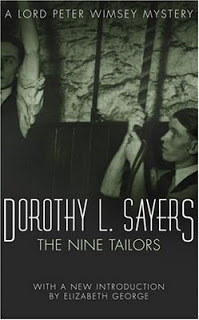
‘A dreadful stock English nobleman of the casual and debonair kind, with the embarrassing name of Lord Peter Wimsey’
Edmund Wilson (1895-1972) was ‘an American writer, literary and social critic, and noted man of letters’ according to Wikipedia.
He was a book reviewer for The New Yorker, and wrote a fairly swingeing piece on detective fiction in 1944 called ‘Why do people read detective stories?‘
He followed this up in 1945 with a more famous piece, ‘Who cares who killed Roger Ackroyd?‘ in which he described receiving a flood of correspondence from outraged mystery fans and resolving to read the titles they most frequently recommended.
Why am I sharing this? Because I have just finished The Nine Tailors, and enjoyed it, and he essentially destroys the book in a few hundred words…
The writer that my correspondents were most nearly unanimous in putting at the top was Miss Dorothy L. Sayers, who was pressed upon me by eighteen people, and the book of hers that eight of them were sure I could not fail to enjoy was a story called The Nine Tailors. Well, I set out to read The Nine Tailors in the hope of tasting some novel excitement, and I declare that it seems to me one of the dullest books I have ever encountered in any field.
He goes on to criticise almost everything I enjoyed in the book, starting with the campanology and the humorous locals:
The first part of it is all about bell-ringing as it is practised in English churches and contains a lot of information of the kind that you might expect to find in an encyclopedia article on campanology. I skipped a good deal of this, and found myself skipping, also, a large section of the conversations between conventional English village characters.
[…]
Not a bad idea for a murder, and Conan Doyle would have known how to dramatize it in an entertaining tale of thirty pages, but Miss Sayers had not hesitated to pad it out to a book of three hundred and thirty … larding the whole thing with details of church architecture, bits of quaint lore from books about bell-ringing and the awful whimsical patter of Lord Peter.
And finally, he takes a shot at Sayers’ literary style:
I had often heard people say that Dorothy Sayers wrote well, and I felt that my correspondents had been playing her as their literary ace. But, really, she does not write very well: it is simply that she is more consciously literary than most of the other detective-story writers and that she thus attracts attention in a field which is mostly on a sub-literary level. In any serious department of fiction, her writing would not appear to have any distinction at all.
The thing is, it’s difficult to refute any of Wilson’s points, aside from arguing that it’s all a matter of taste. He writes with a sort of self-aware literary snobbery, which gives him an air of authority. I’m sure I can’t be the only genre fan with a feeling of literary inadequacy lurking somewhere in the back of my mind, and if even Dorothy L. Sayers doesn’t make the grade, where does that leave the crime novel?




Pingback: Dorothy L. Sayers: The Nine Tailors | Past Offences
Rich – I think that’s been an issue for a long time – this perceived hierarchy of ‘literary’ vs ‘genre’ fiction. There is in my opinion no need for such a hierarchy and not much need for a lot of distinction between the two…
LikeLike
I’m a real fan of Edmund Wilson, as well as Sayers, but I don’t necessarily think he’s always right! There were plenty of other people writing in the 1930s, literary authors, who would be open to many of the same criticisms, and I quite often criticize Sayers myself, but I don’t think his points kill her! (And he failed in his attempt – people are still reading The Nine Tailors more than 80 years after it was written.) And – he kept skipping? He didn’t read it properly? Any book that relies a lot on atmosphere, as this one does, can’t be judged on a skim-read…
Great pair of articles, Rich, I enjoyed the double focus.
LikeLike
I’ve not heard of this critique Rich but although I don’t think the book is dull I agree we get TMI on bell ringing. Athough saying that I still remember it after first reading this book as a teenager.
LikeLike
Pingback: Book report for October 2012 | Past Offences
this book has been a family favorite since my mother first read it in the ’60s, and I find myself rereading it every few years or so. The atmosphere of the fens (which reminds me a bit of the southeastern Massachusetts of my father’s birth), the great churches, the bell-lore, all contribute to such a feeling of place and atmosphere that I go about for days feeling as if the sluice gates are nigh to bursting….
LikeLike